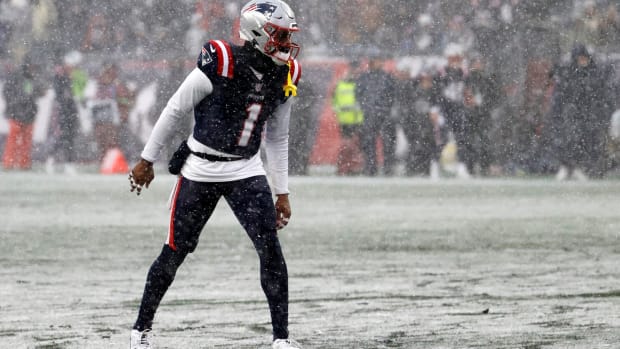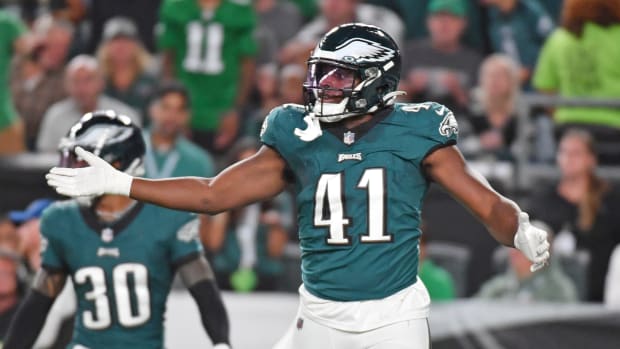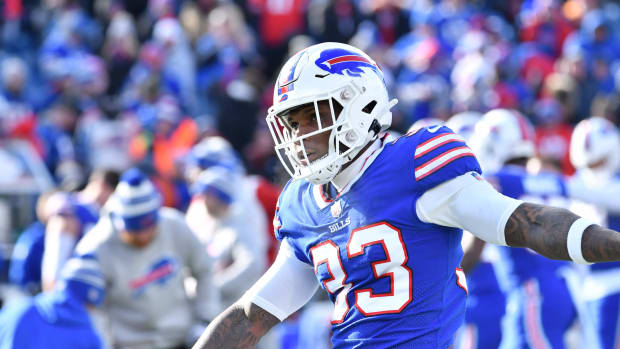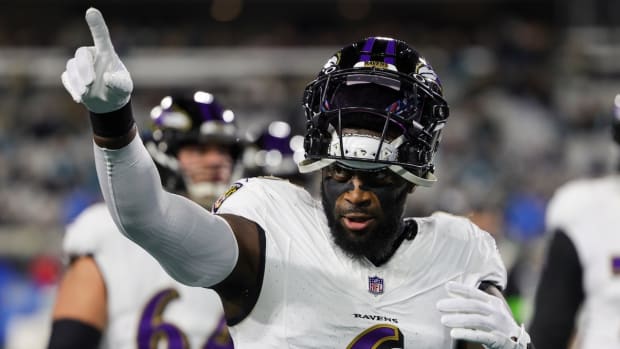SI 64: Nos. 39-35: Paul Dawson, Ereck Flowers, Eddie Goldman, more
With the 2015 NFL draft fast approaching, it’s time for all 32 NFL teams to start getting their draft boards in order and ranking players based on their own preferences. At SI, it’s time for us to do that as well. To that end, Doug Farrar and Chris Burke have assembled their own definitive Big Board, consisting of the players they feel deserve to be selected in the first two rounds.
• The SI 64 (so far): Counting down top prospects in 2015 NFL draft
Our previous set of scouting reports hit on the prospects ranked Nos. 44-40, including Jalen Collins and Devin Smith. This next set of five soon-to-be rookies places a greater focus along the line of scrimmage, with an OT, DT and two aggressive, playmaking defenders. There is a wide receiver in the mix, too, in case you're an offensive-minded football fan.
The next group of SI64 prospects:
39. Paul Dawson, LB, TCU
Bio: Dawson probably spent more time on defense at the scouting combine than he did during any game he played in college. After the 6'0", 235-pound linebacker ran a 4.93 40-yard dash, shocking most in attendance, Dawson turned to Twitter:
That might be a bit of a stretch, but Dawson's tape doesn't show a slow player at all—in fact, the high-school receiver who spent a season a Trinity Valley Community College before catching on at TCU is coming into the NFL at the perfect time, because the league is far more open to inside linebackers with his physical traits as every-down defenders. Amassed 136 tackles, six sacks, four interceptions, five passes defensed and two forced fumbles in 2014, which illustrates the high side of his versatility.
Strengths: Much quicker on the field than his combine time would indicate. Fits the modern profile of the lighter, faster linebacker who can still close quickly to the running back and make consistent tackles. Tracks the ball adeptly from sideline to sideline and has lateral speed to converge on receivers. Doesn't have pure power to beat blocks, but has learned to move around and through trash with timed speed and gap awareness. Excellent in coverage—can deal with slot receivers on a regular basis and has plus ball skills. Takes very quick angles, but avoids getting fooled in misdirection. Good blitz player as long as he finds the gaps—again, relies predominantly on speed. Fundamentally sound wrap tackler. Excels in nickel base situations where he can employ his specific skill set—which again, mirrors the way the NFL is going.
Weaknesses: Dawson will likely require bigger players in front of him at the next level to succeed in the run game. He's not equipped to deal with larger, more powerful blockers at all and may struggle against more experienced offensive lines. May have reached his physical peak from a speed/power perspective. Some questions about his study habits and commitment, as well as the relative simplicity of the TCU defense.
• KING: This former Green Beret is making his final push to the NFL
Conclusion: Dawson isn't going to be a franchise-defining defender with his relatively slight build unless he becomes more defined in his reads, but at his best, he's a quick and intense player with a lot of potential to become a half-field linebacker. It's an automatic default to compare every small, fast linebacker to Lavonte David, but Dawson isn't there yet—David came into the NFL with a superior ability to diagnose what was in front of him. His stats were elevated in TCU's 4-2-5 defense, but Dawson would be a nice fit as a weakside 'backer in a defense where nickel is the base.
Pro Comparison: Pat Angerer, retired (Round 2, 2010)
—DF
38. Rashad Greene, WR, Florida State
Bio: Greene set the school record for catches (270) and receiving yards (3,830) in a highly productive career for the Seminoles. He began contributing right away, leading the team in receptions with 38 as a freshman in 2011. Just under six feet tall and with an 180-pound frame, Greene can be productive from multiple spots at the NFL level, as long as his team maximizes his attributes and understands where he best fits.
Strengths: Played all over the field. Not a burner downfield, but has a smooth gliding stride with a second gear when he gets open. Tracks the ball very well and adjusts nicely to balls thrown away from him—can set the bar in vertical battles. Uses short-area speed to gain separation from defenders. Sinks into his cuts well and has a fairly comprehensive route understanding. Is not afraid to bring the ball in when in congested situations. Field-aware player who sinks into zone coverages and other openings. Adds value as a return man. By all accounts, a gym rat and natural leader.
Weaknesses: Very lean player with limited potential to beef up. Not a top-level tackle-breaker; needs clear openings to extend plays downfield. Physical for his size, but could run into trouble as a slot receiver unless he develops a bit more ability to bounce off first contact. Willing but underwhelming blocker. Doesn't fit the profile of a number-one receiver, most likely a complementary player with slot and flanker attributes. Occasionally loses focus and can drop the ball at times.
• BANKS: Mock Draft 2.0: Who's off the board after the second pick?
Conclusion: Greene is coming into the NFL at the right time, when the slot receiver isn't a devalued entity, and many teams see that position as a starting one. Because of this, his size will be less of an issue than it would have been years ago. A naturally smooth player who can operate very well in space, he could be a highly productive player in a creative, multi-receiver base offense.
Pro Comparison:Doug Baldwin, Seahawks (undrafted, 2011)
—DF
37. Ereck Flowers, OT, Miami (Fla.)
Bio: Flowers made an impact on Miami's line starting his freshman year, when he played in all 12 of Miami's games, starting four times. He started all 13 games at left tackle in 2013 and another 12 in '14, missing one with a knee injury. That injury, suffered in late October, threatened to end Flowers's junior season, but he bounced back quickly. Flowers completed 37 bench-press reps at the combine, more than any other player participating in the event.
Strengths: Arguably plays with as much of an edge as any offensive lineman in this draft class. Stays engaged up to, and at times even through, the whistle. Wants to bury any defender in his path, with the strength to do so in the run game. Checks off the toughness box, too—Flowers missed just one game after surgery on his injured knee last season. Quick getting lateral or forward, a skill that should only improve as he settles into an NFL offense. Stands 6'6" and has 34 1/2-inch arms, so he can hide some of his mistakes with his size. Adept at finding blitzers. Hard for pass-rushers to run through because of base. Can set and reset when dealing with power attacks. Recovers well in general, if he's beaten wide.
Weaknesses: Team that drafts him will have to live with some penalties. Will grab hold of defenders if he's about to be beaten, and he starts from a wide arm position as it is. Very clunky footwork during pass-blocking drills at the combine. Those issues are apparent on some of Flowers's film, as well. Upper body gets ahead of his feet, leaving him in difficult spots, leading to some of those penalties. Not as dominant a run blocker as his size might indicate, especially when he's on the move to the second level. Might need to tone down his aggressiveness some so as to not find himself in post-whistle trouble.
• FARRAR: UW's Marcus Peters doing all the right things ahead of draft
Conclusion: There will be safer picks in this year's draft and rookie offensive tackles who enter the league with more polish on their games. What Flowers lacks in refinement, he makes up for in size and potential. He should be successful early in the run game. How quickly he can iron out the inconsistencies in his pass protection will determine the waiting period on Flowers claiming a starting job. There are a few too many clumsy moments in his game right now. But glimpses at what the finished product could look like have him sniffing Round 1.
Pro Comparison: Cordy Glenn, Bills (Round 2, 2012)
—CB
[pagebreak]
36. Alvin "Bud" Dupree, DE/OLB, Kentucky
Bio: Most people weren't entirely aware of Dupree's freakish athleticism until he showed up at the scouting combine and blew everyone away with a 4.56 40-yard dash at 6'4" and 269 pounds. But this is no workout wonder—Dupree leaves the Wildcats as the SEC's active leader in career sacks with 23.5 over four seasons. He also amassed 37 tackles for loss, 247 total tackles, four forced fumbles and an interception return for a touchdown. NFL teams looking for full-field linebackers will have Dupree high on their boards, as long as they believe that his relative lack of physicality is a matter of better technique.
Strengths: Versatile player who provides value everywhere from outside linebacker to pass-rushing linebacker to situational end with his hand on the ground. As a stand-up rusher, has tremendous first-step quickness and closes to the pocket in a hurry. Bends the edge in space quickly enough for blockers to struggle in adjustment. Can mirror tight ends and slot receivers in coverage and could be used very creatively in that regard in defenses with a high percentage of nickel and dime schemes. Moves into short and intermediate coverage adeptly, keeping his eyes front for running backs and mobile quarterbacks. Ideal build for a multi-gap pass-rusher—long arms and a muscular frame.
Weaknesses: Doesn't have the raw strength to play to his size—comes off the ball too high too often and can easily be taken out to either side by blockers. Occasionally will get poleaxed by outside blockers, including tight ends. Needs room off the edge to be consistently disruptive, because he displays limited hand movement and engages more than he sheds blockers. Go-to pass rush move at this point is pushing off the blocker to either side—must be more versatile with his technique. Overpursuit has him tacking bad angles more often than you'd like—needs to be more aware of his surroundings.
• KAPLAN: 27-year-old prospect taking final steps of journey to NFL draft
Conclusion: Dupree's sack numbers and combine speed will have some projection him as a endbacker at the NFL level, but he's going to find that a struggle until he either plays to his combine weight or develops his array of hand moves. The hope should be that Dupree's NFL team will exploit his abiity to attack and cover in space, because that's what makes him pop off the tape—and could be his road to success at the next level. Ayers didn't have Dupree's sack totals at UCLA, but he came into the NFL as a versatile player who amassed six interceptions for the Bruins in three seasons. Dupree could be that kind of player... or he could be a tweener waiting to happen.
Pro Comparison: Akeem Ayers, Rams (Round 2, 2009)
—DF
35. Eddie Goldman, DT, Florida State
Bio: NFL teams covet versatility in defensive linemen more than ever, which makes Goldman an attractive prospect in that regard. He appeared in 10 games for the Seminoles as a true freshman in 2012, advancing to a starting defensive end position in 2013—at 6'4" and 336 pounds. The 2014 season saw him move inside to a more natural tackle position, and Goldman responded with 35 total tackles, four sacks and eight tackles for loss. Goldman will never be a stat creator; his primary role is to soak up blocks for his defensive teammates—and though he's inconsistent in that role at times, there's enough tape proving his potential to make him a possible second-round pick.
Strengths: Can play run-stopping end, two-gap to either side or one-tech shade nose tackle effectively. When he comes off the snap quickly, has the potential to blow up blocks and disrupt. Has impressive speed for short stunts around the line and closes quickly to the pocket when he has a headstart. Will occasionally turn his shoulder in to the guard and shoot through to get pressure. Embryonic swim move could be devastating if he develops it. Bull rush is highly effective when he uses it. Could be a wrecking machine with a coaching staff that teaches him technique.
Weaknesses: Goldman spends too much time middling around the line when he moves late off the snap and meets blocks too high in his stance. Needs to use his leverage more consistently with a lower set. Can be enveloped to either side by double teams. Not as disruptive and violent with his hands as you'd like; tends to spar and wrestle as opposed to moving in and dominating. Will occasionally be rocked right back off his foundation—not good for a guy his size. More a gap-clogger than a pure pass-rushing tackle, despite his sack totals. Requires a better focus regarding pushing off blocks to stop the run.
• BANKS: Stacked WR class pushing aside veteran pass-catchers
Conclusion: Yes, Goldman can impress at times as a multi-gap player, but he could be truly special as an interior lineman in a four-man or hybrid front. With a little more flash off the snap and a better utilization of his upper-body strength and hand moves, Goldman has the potential to be one of the more aggressive and consistent run-stopping tackles in the NFL. Any pass rush would be a plus, and should not be the dominantly evaluated aspect of his abilities.
Pro Comparison: Shaun Rogers (Round 2, 2001)
—DF




































